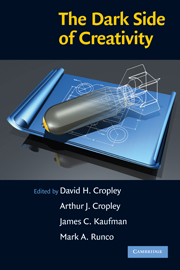Book contents
- Frontmatter
- Contents
- List of Contributors
- 1 The Dark Side of Creativity: What Is It?
- 2 Creativity Has No Dark Side
- 3 Positive Creativity and Negative Creativity (and Unintended Consequences)
- 4 Subjugating the Creative Mind: The Soviet Biological Weapons Program and the Role of the State
- 5 Imagining the Bomb: Robert Oppenheimer, Nuclear Weapons, and the Assimilation of Technological Innovation
- 6 The Innovation Dilemma: Some Risks of Creativity in Strategic Agency
- 7 Early Creativity as a Constraint on Future Achievement
- 8 Boundless Creativity
- 9 Reviewing the Art of Crime: What, If Anything, Do Criminals and Artists/Designers Have in Common?
- 10 Creativity in Confinement
- 11 Creativity and Crime: How Criminals Use Creativity to Succeed
- 12 So You Want to Become a Creative Genius? You Must Be Crazy!
- 13 Both Sides of the Coin? Personality, Deviance, and Creative Behavior
- 14 Neurosis: The Dark Side of Emotional Creativity
- 15 Dangling from a Tassel on the Fabric of Socially Constructed Reality: Reflections on the Creative Writing Process
- 16 Creativity in the Classroom: The Dark Side
- 17 The Dark Side of Creativity and How to Combat It
- 18 A Systems Engineering Approach to Counterterrorism
- 19 Malevolent Innovation: Opposing the Dark Side of Creativity
- 20 Summary – The Dark Side of Creativity: A Differentiated Model
- Index
- References
1 - The Dark Side of Creativity: What Is It?
Published online by Cambridge University Press: 05 June 2012
- Frontmatter
- Contents
- List of Contributors
- 1 The Dark Side of Creativity: What Is It?
- 2 Creativity Has No Dark Side
- 3 Positive Creativity and Negative Creativity (and Unintended Consequences)
- 4 Subjugating the Creative Mind: The Soviet Biological Weapons Program and the Role of the State
- 5 Imagining the Bomb: Robert Oppenheimer, Nuclear Weapons, and the Assimilation of Technological Innovation
- 6 The Innovation Dilemma: Some Risks of Creativity in Strategic Agency
- 7 Early Creativity as a Constraint on Future Achievement
- 8 Boundless Creativity
- 9 Reviewing the Art of Crime: What, If Anything, Do Criminals and Artists/Designers Have in Common?
- 10 Creativity in Confinement
- 11 Creativity and Crime: How Criminals Use Creativity to Succeed
- 12 So You Want to Become a Creative Genius? You Must Be Crazy!
- 13 Both Sides of the Coin? Personality, Deviance, and Creative Behavior
- 14 Neurosis: The Dark Side of Emotional Creativity
- 15 Dangling from a Tassel on the Fabric of Socially Constructed Reality: Reflections on the Creative Writing Process
- 16 Creativity in the Classroom: The Dark Side
- 17 The Dark Side of Creativity and How to Combat It
- 18 A Systems Engineering Approach to Counterterrorism
- 19 Malevolent Innovation: Opposing the Dark Side of Creativity
- 20 Summary – The Dark Side of Creativity: A Differentiated Model
- Index
- References
Summary
FAILURE TO RECOGNIZE THE EXISTENCE OF THE DARK SIDE
In everyday usage as well as scholarly discussions, it is almost axiomatic that creativity is good. Indeed it cannot be denied that it often leads to beneficial advances in art and literature, science, medicine, engineering, manufacturing, business, and other areas (the bright side). Unfortunately, the enchantment with creativity is so intense that, as James, Clark, and Cropanzano (1999) complained, people, including researchers “… typically ignore the fact that a great deal of creative effort is done in service of negative ends” (p. 212). James, Clark, and Cropanzano argued that this has led to an absence of consideration of negative creativity or, as the editors of the present volume would put it, a failure to come to grips with the dark side of creativity. This means that little has been worked out about the “… triggers, processes, outcomes …” (p. 212) of the dark side. The result is obvious: Approaches to recognizing the dark side, avoiding circumstances that foster its growth, discouraging its manifestation, redirecting it, protecting against its negative consequences, and the like, are not well developed. The purpose of this book is to increase both awareness of the dark side and understanding of the forms and processes of negative creativity, begin to develop the necessary conceptual framework, and set in motion a discussion of how to deal with it in practical settings.
- Type
- Chapter
- Information
- The Dark Side of Creativity , pp. 1 - 14Publisher: Cambridge University PressPrint publication year: 2010
References
- 16
- Cited by

